What is an Amplifier?
We see amplifiers in almost all the electronic equipments around us. Though we usually relate them to stereo equipments they are also found in TV’s, computers, MP3 players and so on. All these devices have a speaker which is used to reproduce the original sound.
Therefore an amplifier can be device that is used to change the amplitude of a signal. This increase in amplitude can be calculated by a factor known as transfer function, which is actually the ratio between the output and input given to the amplifier. The magnitude of this transfer function is called the gain of the amplifier.
When referring to electronic circuits, the signal used in an amplifier is mostly either current or voltage. A sound is said to be amplified, when the device makes the sound louder than usual with the same clarity. The amplifiers are divided according to the source that is supposed to be amplified, the driving device, the frequency of the signal and the type of signal.
The source can be an electric guitar and the driving device can be a head-phone amplifier. The frequency of the signal is defined in its range like audio, IF, RF, VHF and so on. The type of signal refers to two parameters – inverting and non-inverting. Another major classification is in the device that is used to design the amplifiers. The most commonly used devices are Field-Effect transistors, and valve.
Role of an Amplifier
The amplification process is similar to the way in which the human receives the sound from our surrounding. When a voice is made it starts to vibrate in the atmosphere, thus beginning to move the air particles in hits. This causes more air particles to be hit and thus creates a vibrating pulse in the air. When it reaches our ears, they will be received as an air pressure and will be converted to the appropriate signals by our brain. We can define the working of amplifiers in the same sense.
Sound waves will be sent through a microphone. The diaphragm of the microphone moves it in a peculiar motion and converts it into electrical signals. This fluctuating electric signal will be represented as compressions and rarefactions of the original sound.
The electric signal will be encoded by the recorder and stored in a tape, CD and so on.
A player for the particular recorded signal interprets the electrical signal and is given to the speaker which turns the cone back and forth. The same variation in pressure will be reproduced by the speaker as it was in the beginning. The basic block diagram of an amlifier is given below.
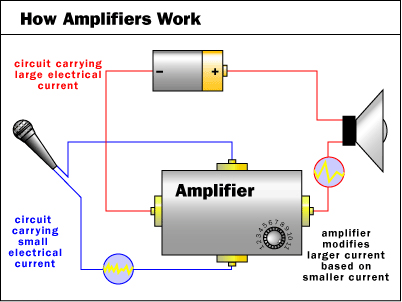
How Amplifiers Work
Basic Elements of an Amplifier
Though the basic explanation of an amplifier was explained above, the making of it is far more complex. We know that there are two signals generated during the process. They are the input signal and the output signal. The input signal is completely different from the output signal. Thus we can consider the generation of these signals as two separate electronic circuits. The input signal circuit is the signal recorded in a tape. It is designed as to modify the output signal circuit with its load. This is done by changing the resistance to the output circuit so as to make new voltage fluctuations of the original sound signal. But this load is very high when compared to the original sound. So, the sound must be first boosted with the help of a pre-amplifier. This will help in making a much more strong output signal as the input to the power amplifier. There is no much difference in the working of pre-amplifier compared to amplifier. A change in resistance is given by the input circuit to the output circuit, through the power supply. The design and number of pre-amplifiers in an amplifier varies according to the manufacturer.
The output circuit is generated by the power supply of the amplifier. The power supply helps in drawing the required energy from an external battery or power outlet.
Mostly the main power supply will be in ac form. It will be changed to dc and then given to the amplifier. The power supply also helps in making an uninterrupted signal by making the current smoother. This load will then be given to the cone of the speaker.
For all this to work together a combination of many electronic circuits will be needed. The designer has to make sure that each and every part of the audio signal is correctly represented.
Basic Components of an Amplifier
One of the most basic components of an amplifier circuit is the transistor. The materials of the components used for an amplifier, must be able to conduct electric current in a varying manner. That is why the transistor is often used. The working of an N-P-N transistor is given below.
We know that N-type semiconductors carry electrons and P-type semiconductors carry holes. In an N-P-N transistor, the P-type semiconductor will be kept in between two N-type semiconductors. This is illustrated below.
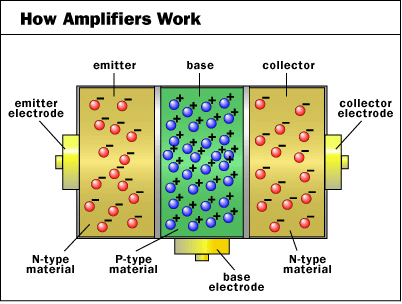
Working of transistor in an Amplifier
The N-type electrons and the P-type holes start to get attracted. But, the number of free electrons is way higher than the number of holes. This will result in the combination and the filling up of holes. As a result of this combination depletion holes will be created at the boundaries of the N-type and P-type. This will cause the semiconductor material to switch back to its insulating state. Thus the charges get accumulated with no other place to go. Thus the depletion zones get heavier. Thus the movement of charge from the emitter to the collector reduces, even if there is a huge difference in voltage between the two electrodes. This situation has to be overcome.
For the problem to be solved, a high voltage supply must be given to the base terminal. As the input current controls the base terminal its flow will cause the base terminal to have a higher positive charge and thus attracts the electrons from the emitter terminal. This in turn reduces some holes and thus reduces the size of the depletion region. This will help in an easier movement of the charges from the emitter to the collector. All these actions cause a natural increase in the conductivity of the transistor.
In short, the voltage given to the base terminal decides the amount of conductivity of the transistor and the size of the depletion region. Here is the diagram of the working of a transistor as an amplifier.
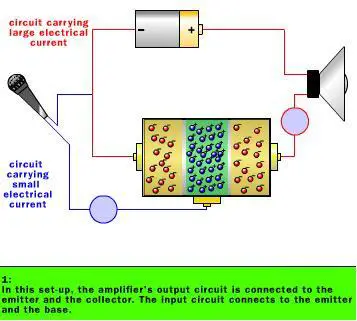
Working of Amplifiers-Step 1
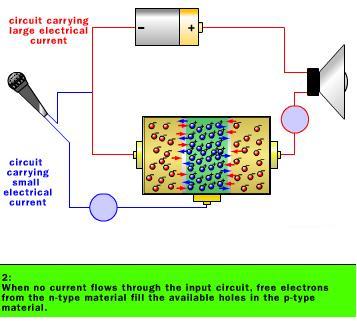
Working of Amplifiers-Step 2
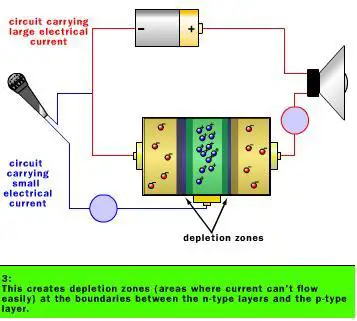
Working of Amplifiers-Step 3
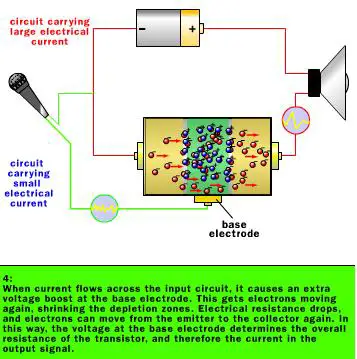
Working of Amplifiers-Step 4
The output power produced in an amplifier depends on the necessity of its use. If it is used in some huge hall, the amplifier must produce an output power of at least a thousand watts. On the other hand, if it is used in a home theatre stereo amplifier, it may just need a few hundreds of watts as the output power. If it is in a speaker phone, the output will be the least of half a watt.
Whatever the power may be, an amplifier must produce the least amount of distortion as possible. On the same time, the boosting of the sound must be high in the final driving stage and a high replica of the original sound must be produced. For these characteristics to occur accurately, the parameters like power rating, input impedance, output impedance and also fidelity must be varied accurately.
By the concept of amplifiers we always think of amplifying sound. But, the same process can be done for amplifying radio signals and video signals as well.
Share this on your favourite network







0 comments:
Post a Comment